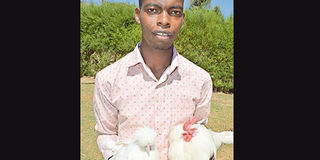Youth finds hidden wealth in turkeys, ornamental birds

Onesmus Kibe displays birds that he keeps in Nanyuki. He has 32 mature turkeys and 53 poults. Kibe also has 28 mature geese, 30 pekins, 28 guinea fowls, 27 muscovy and 18 keets. PHOTO | PETER CHANGTOEK | NATION MEDIA GROUP
What you need to know:
- The farmer uses starter feeds for poults, growers for young birds and layers mash for those producing eggs. According to Kibe, turkeys need more protein than chickens.
- The mature birds are fed once in the morning before they are left to roam the farm while the young ones get food twice. Apart from turkeys, Kibe also keeps geese, pekin ducks, Muscovy ducks, guinea fowls and chickens.
- A turkeys lays 10 to 12 eggs for beginning birds but the number grows to 15. His greatest problem is Newcastle, coccidiosis, fowl pox, blackhead and other poultry diseases.
Onesmus Kibe, 26, vividly remembers when his father bought two turkeys nearly two years ago. He had no idea it would turn into a flourishing business.
At his father’s two-and-a-half-acre land in Nanyuki, Laikipia County, Kibe is now getting the rewards of rearing turkeys and other ornamental birds.
“My father bought the male and female turkeys to add beauty to his compound. It did not take long before the female started laying eggs. We had 15 poults when the eggs hatched. We sold 10 of the 15 chicks when they were two months old. Each went for Sh2,000. That is when I found out that rearing turkeys is profitable,'' Kibe says. He bought six more female turkeys.
“Since then, I have been selling young turkeys and remaining with the breeding stock. I also buy birds to avoid inbreeding,” he says. Kibe says the first two birds cost Sh8,000, with the male going for Sh3,500.
“At that time, I used home-made feeders to cut costs. I improvised plastic tins and old plates,” Kibe adds.
The birds are housed in simple structures made of wood and wire mesh. The structures are two feet high.
“The lower structure is for young ducks and geese. The upper one is partitioned after every five feet and every room has about 20 poults,” the young farmer says. He prefers the free range system for the mature turkeys.
“The houses are for the chicks only. The poults remain there for three months before being sold,” Kibe adds. He says the turkey market in Kenya is largely unexploited.
The farmer uses starter feeds for poults, growers for young birds and layers mash for those producing eggs. According to Kibe, turkeys need more protein than chickens.
FEEDS ARE EXPENSIVE
“The commercial feeds do not have enough protein so I add omena (daggaa) to their food. I also move from hotel to hotel to get leftover food,'' he adds.
The mature birds are fed once in the morning before they are left to roam the farm while the young ones get food twice. Apart from turkeys, Kibe also keeps geese, pekin ducks, Muscovy ducks, guinea fowls and chickens.
He has 32 mature turkeys and 53 poults. Kibe also has 28 mature geese, 30 pekins, 28 guinea fowls, 27 muscovy and 18 keets.
A turkey egg goes for Sh150. Nevertheless, the farmer prefers to hatch the chicks instead of selling the eggs for that is more profitable.
A turkeys lays 10 to 12 eggs for beginning birds but the number grows to 15. His greatest problem is Newcastle, coccidiosis, fowl pox, blackhead and other poultry diseases.
“Vaccinating and treating birds is expensive,” he says. Another challenge is selling his birds.
"I don't really have a stable market for turkeys like hotels, so I depend on individual buyers. Feeds are expensive, with some going for about Sh40 per kilogramme,'' he says.
He does most of his deliveries by public transport, especially to towns directly connected to Nanyuki.
It is therefore almost impossible for Kibe to deliver birds to far-flung towns like Kisumu, Nairobi, Kakamega and Mombasa. To keep diseases at bay, the shelter for the birds must remain clean.





